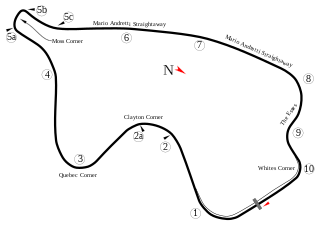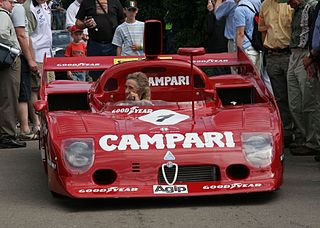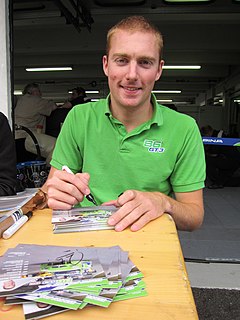Related Research Articles

Canadian Tire Motorsport Park is a multi-track motorsport venue located north of Bowmanville, in Ontario, Canada, 64 km (40 mi) east of Toronto. The facility features a 3.957-kilometre (2.459 mi), 10-turn road course; a 2.9-kilometre (1.8 mi) advance driver and race driver training facility with a 0.40-kilometre skid pad and a 1.5-kilometre (0.93 mi) kart track. The name "Mosport", a portmanteau of Motor Sport, came from the enterprise formed to build the track.

The Caesars Palace Grand Prix was a car race held in Las Vegas between 1981 and 1984. For the first two years, the race was part of the Formula One World Championship, before becoming a round of the CART series in 1983. Nissan/Datsun was a presenting sponsor of both races.

Patrick Daniel Tambay is a French former racing driver. He competed in 123 Formula One World Championship Grands Prix, winning twice, securing five pole positions and scoring a total of 103 Championship points. In 2005, he raced in the inaugural season of the Grand Prix Masters formula for retired Formula One drivers, and continued in the series in 2006.

All American Racers is an American auto racing team and constructor based in Santa Ana, California. Founded by Dan Gurney and Carroll Shelby in 1964, All American Racers initially participated in American sports car and Champ Car races as well as international Formula One events with cars named Eagle. The Formula One team, based in the United Kingdom and using British-built Weslake engines was named Anglo American Racers. Under team manager Bill Dunne they set up shop in Rye, East Sussex. The team were adjacent to Harry Weslake's engine development plant and half a mile from Elva cars. They participated in 25 Grands Prix, entering a total of 34 cars.

Road America is a motorsport road course located near Elkhart Lake, Wisconsin, United States on Wisconsin Highway 67. It has hosted races since the 1950s and currently hosts races in the NASCAR Cup and Xfinity Series, WeatherTech SportsCar Championship, IndyCar Series, SCCA Pirelli World Challenge, ASRA, AMA Superbike series, and SCCA Pro Racing's Trans-Am Series.
Chaparral Cars was a pioneering American automobile racing team and race car developer that engineered, built, and raced cars from 1963 through 1970. Founded in 1962 by American Formula One racers Hap Sharp and Jim Hall, it was named after the roadrunner, a fast-running ground cuckoo also known as a chaparral bird.

The Alfa Romeo Tipo 33 was a sports racing prototype raced by the Alfa Romeo factory-backed team between 1967 and 1977. These cars took part for Sport Cars World Championship, Nordic Challenge Cup, Interserie and CanAm series. A small number of road going cars were derived from it in 1967, called Alfa Romeo 33 Stradale.
John Lee Paul Jr. was an American racing driver. He competed in CART and the Indy Racing League competitions, but primarily in IMSA GT Championship, winning the title in 1982.

Edmonton International Speedway, also known as Speedway Park, was a 251-acre (1.02 km2) multi-track auto racing facility located in the present Cumberland and Hudson neighbourhoods of Edmonton, Alberta, Canada. The facility featured a 1⁄4-mile (400 m) dragstrip, a 2.53-mile (4.07 km) 14-turn road course, and a 1⁄4-mile short oval. At its peak, it had capacity for over 30,000 fans.
The 1975 Australian Sports Car Championship was a CAMS sanctioned Australian motor racing title open to Group A Sports Cars and Group D Production Sports Cars. The championship was contested over a single race staged at the Phillip Island circuit in Victoria, Australia on 30 November 1975. The race was run over 30 laps of the 4.76 km circuit, a total race distance of 143 km. It was the seventh Australian Sports Car Championship, and the only one in the twenty-year history of the title to be contested over a single race rather than over a series of races.

Marc VDS Racing Team is a motorcycle racing team founded by Belgian owner Marc-Oswald van der Straten-Ponthoz, descendant of the founder of the Stella Artois brewery. The team competes in motorcycle racing in the Moto2 World Championship under the name ELF Marc VDS Racing Team. The team has previously competed in the MotoGP and MotoE classes. It also previously competed in many auto racing championships, particularly in grand touring classes - namely the FIA GT1 World Championship, the Blancpain Endurance Series, and the European Le Mans Series - as well as the NASCAR Whelen Euro Series. They have also previously contested in rallying at various rally raid events, such as the Dakar Rally.

Maxime Martin is a Belgian professional racing driver and son of four-time Spa 24 Hours winner Jean-Michel Martin. He currently is an Aston Martin Racing driver for which he competed in the FIA World Endurance Championship between 2018 and 2020. Martin had been a BMW factory driver since 2013, racing full-time in the American Le Mans Series for BMW Team RLL that season, as well as acting as BMW's DTM test and reserve driver. In late 2013 at BMW Motorsport's yearly review, Martin was confirmed as a full-time BMW DTM driver for the 2014 season.
The 1981 Can Am series season was the fourteenth running of the Sports Car Club of America's prototype-based series, and the fifth running of the revived series. Geoff Brabham was declared champion, despite only winning two races. Chevrolet again dominated the season. The dominant chassis manufacturers were March, Lola, Holbert, Frissbee, and VDS. IndyCar drivers Al Unser and Bobby Rahal also podiumed at Road America and Mosport, respectively.
The 1982 Can Am Series season was the fifteenth running of the Sports Car Club of America's prototype series, and the sixth running of the revived series. 1982 brought new competition for Chevrolet in the form of Hart and Cosworth. Hart would podium in three races while Cosworth would podium in two. The most dominant chassis were Frissbee, Marguey, March, VDS-001, and Ensign. Al Unser, Jr. would win at Road Atlanta, Laguna Seca, and Mosport twice, with a podium at Mid Ohio, at Riverside, and at Caesar's Palacae. Unser would be declared champion.

The Ralt RT4 is an open-wheel formula racing car, designed, developed and built by Ralt, for Formula Atlantic, in 1981. It was later converted into a closed-wheel prototype, and used in the revived Can-Am series, between 1982 and 1985, where it achieved only modest success; where it achieved 1 podium finish, 1 class victory, and a best result of a 2nd-place finish.

The Penske PC-10 is a CART open-wheel race car, designed by Penske Racing, which was constructed for competition in the 1982 season. Designed by Geoff Ferris, it is considered possibly the most dominant Penske race car design ever and that from a team that typically dominated. Rick Mears has been quoted as acknowledging this was his favorite racecar chassis ever. Twelve total were made (1-12), six raced by Penske (1-6), with four confirmed destroyed. They were manufactured at Penske Cars, Ltd. in Poole, England during 1982, and delivered to Penske Racing, Inc., in Reading, Pennsylvania. So outstanding was the PC-10's design, it won the prestigious Louis Schwitzer Award for innovation and engineering excellence in the field of race car design at the Indianapolis 500 in 1982. The PC-10s were active in the years 1982–1984. In fact, the PC-10 was ultimately much better than the following year PC-11, so Roger Penske bought back one of the PC-10s he had sold to another team for the 1983 season, and which then won another race for his team.
The Lola T530 is a purpose-built Can-Am sports prototype, designed by British manufacturer Lola Cars in for the revived Can-Am series 1980. It was very successful, winning 7 of the 9 races in its first season of competition alone, and gave Patrick Tambay the championship with Carl A. Haas racing Team. Geoff Brabham won the championship in 1981; despite only winning 2 races. It was used in Can-Am racing until 1983. It was later used in the international Interserie racing series, and the British Thundersports racing series, between 1984 and 1988. Between 1980 and 1988, it scored a total of 32 race wins, and 43 podium finishes; a very impressive tally indeed. As with all other full-size Can-Am cars of the time, it used a mid-mounted 5-liter, naturally-aspirated, Chevrolet V8 engine. A total of 10 chassis' were built.

The March 822 was an open-wheel, developed and built by British racing car manufacturer March Engineering in 1982, which was designed in accordance with Formula 2 regulations. In 1982 and 1983 numerous drivers took part in the Formula 2 European Championship and the Japanese Formula 2 Championship. In 1982, Corrado Fabi became European Formula 2 Champion on a March 822, and Satoru Nakajima won the Japanese championship in the same year. A derived version, called the 82A, was used in the Formula Atlantic series.
The VDS-002 was an American closed-wheel sports prototype race car, designed, developed, and built by Racing Team VDS for the revived Can-Am series, in 1983. Michael Roe won the 1984 Can-Am Championship outright in the car, and together with the VDS-004, won a total of 7 of the 10 races that season. As with most Can-Am cars of the time, it was powered by the commonly used 5.0 L (310 cu in) Chevrolet small-block motor.
The VDS-004 was an American closed-wheel sports prototype race car, designed, developed, and built by Racing Team VDS for the revived Can-Am series, in 1984. It debuted at the fifth race of the 1984 season, at Road Atlanta. Michael Roe won the 1984 Can-Am Championship outright in the car, and together with the VDS-002, won a total of 7 of the 10 races that season. As with most Can-Am cars of the time, it was powered by the commonly used 5.0 L (310 cu in) Chevrolet small-block motor.
References
- ↑ "VDS 001 Chev – primotipo…". primotipo...
- ↑ https://www.racingsportscars.com/chassis/photo/VDS-001.html
- ↑ "VDS-001" . Retrieved 20 June 2022.
- ↑ "VDS 001" . Retrieved 20 June 2022.
- ↑ "Can-Am Series". conceptcarz.com.